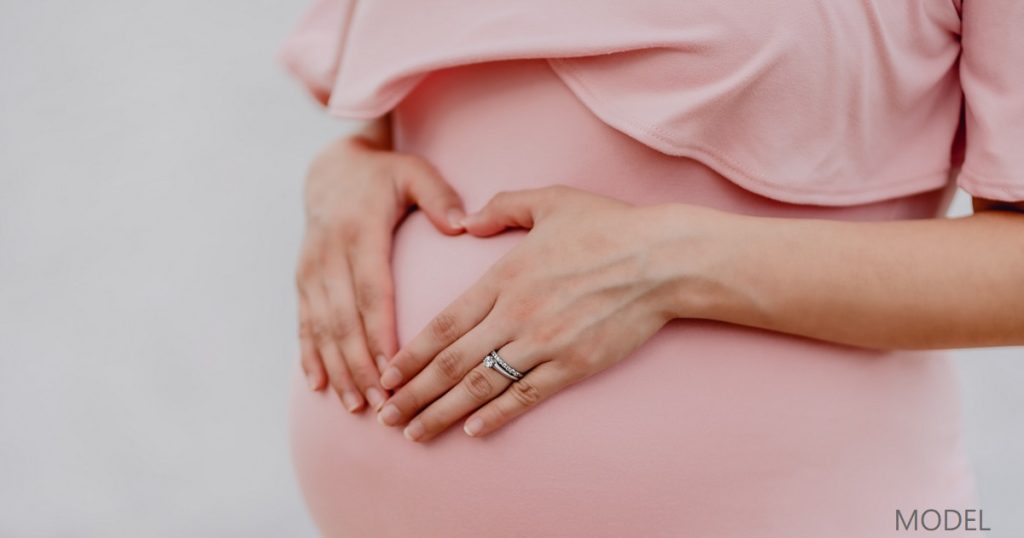Pregnancy is a beautiful thing. There is nothing like growing a new life inside of you and enjoying the wonder of a new baby, but it can take a serious toll on your body. After giving birth, many women complain that their bodies are not the same, with sagging, loose skin on the abdomen and pubic area, stretched out abdominal muscles that just won’t respond to exercise, unwanted pockets of fat that don’t go away no matter how much you diet. That’s why I offer tummy tuck surgery (abdominoplasty) at my San Antonio plastic surgery practice to help restore your shape and repair the damage caused by pregnancy to your abdominal area.
Tummy Tuck to Tighten Muscles and Remove Excess Skin After Pregnancy
One of the most common reasons a woman decides to have a tummy tuck after giving birth is to tighten and repair damage to the muscular wall (abdominal recti muscles) caused by weight fluctuations or childbirth. No amount of diet and exercise can repair muscles that have separated during pregnancy.
Repairing separated abdominal muscles can be performed using various tummy tuck techniques such as permanent or absorbable sutures and running sutures which stitch the wound closed using a long single stitch, or interrupted sutures which use multiple sutures to close the incision. Each technique is effective for repairing separated muscles and removing unwanted excess skin and fat during a tummy tuck procedure.
For women who underwent a C-section, a tummy tuck to repair their abdominal muscles can be even more complicated, depending on how the physician made the incision in the abdominal wall.
Regardless of technique, there is some inherent risk associated with a pregnancy after tummy tuck. The increases of intra-abdominal pressure or volume that occurs with childbirth will undeniably put new stress on the repaired muscles. My goal with a tummy tuck is to repair and strengthen your abdominal muscles, remove excess skin and fat, and give you back the shape you had before you were pregnant.
Can a Tummy Tuck Repair a Deflated, Saggy Pubic Area?
During your consultation, I will examine your abdominal and pubic area to assess your skin and the underlying structures to determine the best treatment for your needs.
Abdominoplasty techniques vary from surgeon to surgeon. Some incorporate a monsplasty as part of an abdominoplasty. A monsplasty may include defatting the pubic region and sewing it higher up on the abdominal wall to make it appear less deflated and saggy. If a monsplasty is combined with a tummy tuck, most patients often experience swelling of the pubic region for 6 weeks or more, but it does subside over time.
How Much Weight Can I Lose from Tummy Tuck Surgery?
Abdominoplasty is a body contouring procedure designed to remove excess skin and tighten the abdominal muscles. It is not intended to be a weight loss procedure.
Undoubtedly, removing excess skin and fat from the abdominal area will reduce some weight depending on the amount of skin being removed and its thickness, but it will not act as a weight loss procedure. I have seen tummy tuck procedures remove as much as 10-12 pounds, but this an exception, not the rule.
I recommend that patients undergoing an abdominoplasty be at their goal weight and have a BMI of roughly 30-35 to achieve an optimal outcome from their tummy tuck procedure.
Can A Tummy Tuck Be Covered By Insurance?
Tummy tuck surgery is considered an elective cosmetic procedure with is usually not covered by insurance.
Insurance carriers and individual insurance plans vary a great deal on what is covered. Some plans will cover a diastasis repair, or a tightening of the abdominal rectus muscle separation. Other insurance plans may also cover a panniculectomy procedure to remove the excess skin or “apron” that falls below the belly button.
If the pannus causes skin rashes that are not improved with topical dermatologic treatments or restricts you from wearing normal clothing and performing regular activities, then your insurance may cover a panniculectomy.
It is worth contacting your insurance company after your tummy tuck consultation to determine whether or not a portion of your procedure may be covered.
What Is Tummy Tuck Recovery Like?
Every patient’s recovery process varies, but it is important to make sure to give your body time to fully heal.
During consultations, I make sure to educate my patients and have an extensive discussion about expectations before proceeding with tummy tuck surgery. I also provide extensive details on how to prepare for tummy tuck surgery.
I recommend you set up a place in your home that allows for a semi-sitting position without having to climb stairs after surgery. I also recommend plenty of walking but no strenuous activity after surgery for typically 8-12 weeks, depending on your specific situation.
After surgery, I will prescribe an abdominal compression garment for about 6 weeks after surgery – this may will help with swelling and taking tension off the abdominal muscle repair. You may have some drains to help remove and collect fluid after surgery. I will provide instructions on how to care for your incisions, drains, and compression garments after surgery so that you heal as effectively as possible.
After surgery, patients initially feel a tightness in their abdomen because of the muscle repair and excess skin removal. You can expect to walk slightly bent over the initial 1-2 weeks after surgery.
Every patient heals at their own pace, and nothing can replace a thorough in-person examination by your surgeon, so it is important to attend all post-surgery appointments.
If you are interested in learning if you are a good candidate for tummy tuck in San Antonio, please contact my practice at (210) 942-6672 or request a consultation online. I look forward to meeting with you.


Leave a Reply